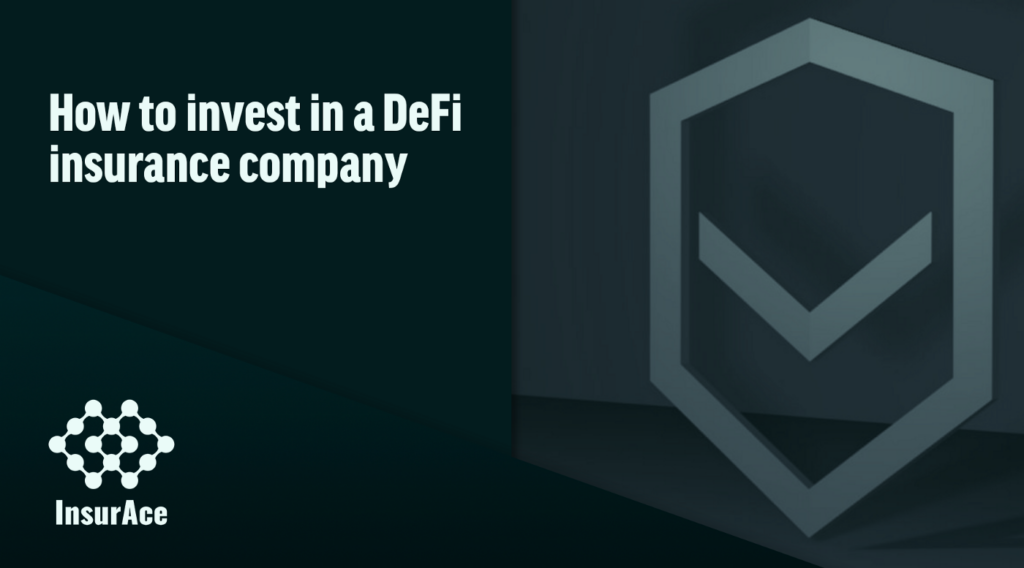DeFi insurance provides coverage from loss due to smart contracts vulnerability in exchange for a premium of between 2–15% of the value covered.
Users can request a free quote after specifying the coverage through a variety of DeFi insurance protocols including InsurAce.io. Some coverage options include protection from smart contracts hacks, multi-sig wallet issues, DAO hacks, and protections against stable coin defaults. Most Defi insurance platforms are community-driven, where members have the power to vote and decide which claim should be provided with coverage.
But what are the benefits do members get that make them become part of it. You can invest in any Defi insurance company by purchasing their tokens and then staking on their platforms. By doing so, you can earn handsome staking rewards on your investments.
In this article, we will explain how you can invest in a DeFi insurance project like InsurAce.io. You will learn how to invest in the DeFi insurance platform, stake their tokens, and earn gains.
Invest in Defi Insurance Company : InsurAce.io:
InsurAce.io is a decentralized alternative to centralized insurance. It utilizes the Ethereum and Binance Smart Chain blockchains and to allows people to share insurance risks. It also creates insurance products.
InsurAce.io has a staking system called underwriting mining. Users can invest by buying $INSUR tokens and then lock up their funds for 30 days or more. Here is a quick review of how the pool staking system works:
1- Purchase $INSUR token
- To purchase INSUR
- Register on Huobi, or go to Uniswap (ETH) or Pancake Swap (BSC)
- Buy stablecoins with fiat currency on Huobi (or other centralised exchange).
- Exchange stablecoins for INSUR tokens on Huobi, or transfer stablecoins to your DEX wallet like MetaMask
- Use Uniswap or Pancake Swap to swap your ERC20 Tokens or BEP20 tokens for INSUR tokens
- Make sure your INSUR ticker is showing in your wallet
- There you will now see your funds. Congratulations, you have invested in a DeFi insurance protocol. However there is more you can do to maximise your returns via Underwriting Mining…
2- Connect Connect your wallet to app.insurace.io and go to the staking page.
3- Stake INSUR to the protocol to receive higher APY than stablecoin or cryptocurrency alternatives.
4- Earn rewards: The reward will be proportional to the APY against the stake and time left in the stake.
There is a section showing “Risks.” There you will find written that if you are staking INSUR, you are exposing yourself to risk if a claim is paid on a smart contract you staked on, you could lose your deposits. So, you can unstake, but still, you will be locked for 15 days unlocking period.
Underwriting mining rewards from incentivized contracts must be claimed manually from the staking rewards dashboard at the end of your lock up, and they do not rollover.
It means if you are staking, you are also earning the tokens, which you will have to claim manually.
Risk of Staking:
Who does not like to earn passive income? We all want, and this is what staking does. Staking has been the hottest trend in the crypto space. It not only allows users to generate extra bucks but also helps to secure the crypto network. But is there any risk associated with staking cryptocurrency? If yes, what are those risks?
In this article, we have covered the risks that come with staking. After reading these, you will be more precise in deciding to stake your coins.
What is Crypto Staking?
Cryptocurrency staking means locking cryptocurrency to receive rewards. It involves holding your funds in the crypto wallet to ensure the decentralised crypto network’s security, integrity, and continuity. Stakers are given incentives in the form of rewards for helping to secure the cryptocurrency network.
Proof of Stake (PoS) is a consensus algorithm that enables the transaction gathering in a block. These blocks are then joined to create a blockchain. It is an alternative of Proof of Work (PoW) which does not facilitate the consensus in the decentralized ecosystem.
Staking crypto has become possible due to the Proof of Stake algorithm, as it allowed users to stake their holdings instead of contributing their computing power to secure the network.
Crypto Staking Risks:
According to a report, stakers can earn reward from 4% to 34% in one quarter that is much better than merely holding the coins. But there are also many risks involved in this process. Some of which are given below:
1-Liquidity Risk:
Loss of liquidity is a risk that stakers have to face. If you are staking a coin with very low liquidity on the exchange, it will become challenging for you to sell your asset or convert the returns into any stable coin.
Choosing the liquid asset with high trading volume on the exchange for staking can help to reduce the liquidity risk.
2-Loss of Holdings:
Cryptocurrency investment is risky. There is a risk of losing your investment and staked assets. It may occur due to the negligence of users, hacking attacks or scams. Users share their private keys and end up losing their assets.
Invest only when you are ready to face the potential loss as well. Keep an offline backup of your wallet and only use reputable crypto wallets. Always prefer decentralized staking platforms. Choose a platform with the best security practices.
3-Volatility Risk:
The rise or fall in the value of cryptocurrency is ubiquitous. The coins can lose or gain their value in a short time. Volatility risk is dangerous in a way that it spread from one point to affect the entire industry. The price of Bitcoin is also a driving factor for the surge or decline in the value of staked coins.
Volatility will affect the staking even if there is not any problem with your coin.
In this case, you can either chose to sell your asset with loss or if you believe that price will increase in the future, you can continue staking.
Price action can lead to impermanent loss relative to the value of the underlying token.
4-Lockup Periods:
While staking your coins, there is a lock-up period of which you must be aware. It is the period in which you do not have access to your staked coins. Even if the prices drop, you cannot unstake it. You have to wait to regain access to your assets after the duration agreed for lock-up.
5-Unguaranteed Staking Rewards:
There are chances that the platform does not give the promised rewards and also that they do not pay even if they were supposed to pay. For example, Tron changed their staking rewards from 7%to 4%.
So always keep a record if you have received your promised staking rewards.
6-Wait for Receiving Reward:
In some cases, you do not receive staking rewards daily and have to wait for receiving the staking rewards. It will not affect your HODL, but you have to wait longer to reinvest and earn more rewards.
It is advisory to choose the assets that pay staking rewards on a daily basis.
7-Counterparty Risk
Scammers surround the Crypto market. There are also cases that a platform could not perform well and end with the project winding up. If the platform goes out of business and delists the coins, the counterparty risk will leave you empty ended.
You may lose all of the coins that you staked on that platform. Therefore, it is always better to first analyze entirely and not go for the platforms promising to give the highest rewards.
8- Validator Risk:
For staking purposes, you must have good technical knowledge of running a validator node. The nodes must have 100% uptime; otherwise, you will have to suffer a penalty if validator nodes play up. It will ultimately affect your staking rewards.
You better use a third-party validator for allocating your staking.
9-Slashing:
The PoS model of blockchain motivates the honest stakers through rewards and also punish the canny actors. Just like in the real world, Slashing is a punishment for dishonest validators in the crypto world. It is in the form of disincentivizing after finding out the fault.
Slashing can happen in any of the following cases:
Security fault: Validating twice or more the same blocks disturbs the network consensus. This is called double baking.
Governance fault: The same consensus process is voted many times by the validator, and votes contradict each other.
Liveness fault: It happens when a validator does not participate for a long time and misses the several.
10-Server Risk:
The platforms which provide staking service use third parties to host their validator nodes. These third parties could break down or become vulnerable to hacking attacks.
The hackers may manipulate the system by discrediting the whole platform users. The users will end up losing their assets. A similar case had been observed with ICOs and cloud mining.
Minimum Holding:
Most of the platforms demand a minimum holding of the coins to become eligible for receiving rewards. You should read the terms and conditions and also if they have made any change to them. You will only receive rewards once you have met their requirement.
Future of Staking:
According to a report by the Ethereum foundation, staking rewards on the Proof-of-Stake blockchain will almost double from $10 billion to $18.9 billion by 2022.
There are already several aggregator sites like stakingrewards.com which highlight the various rewards available on DeFi protocols.
Closing Thoughts:
Cryptocurrency has made many people millionaires and many left empty-handed. If you want to get gains from this industry, you need to do analysis and research before taking any step. Locking up funds in the smart contracts can leave you vulnerable to hacks. It is always essential to use reputable smart contracts, and always insure your holdings through protocols like InsurAce.io
InsurAce platform is a permissionless, blockchain-based Defi insurance service. InsurAce provides insurance for your smart contracts against hacks enabling users to secure their investments. InsurAce gives incentives in the form of INSUR to the participants who stake tokens such as ETH, DAI, BNB, BUSD, and other stable tokens into the platform.
For press enquiries and assets please contact: dan@insurace.io
Join our community:
Email: contact@insurace.io
Telegram: https://t.me/insurace_protocol
Discord: https://discord.com/invite/vCZMjuH69F
Twitter: https://twitter.com/insur_ace
Forum: http://forum.insurace.io


